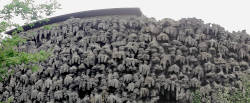Grotesquery
Useful Information

| Location: |
Valdštejnská zahrada, Malá Strana, 118 00 Praha 1.
Valdstejnsky Palac (Wallenstein Palace). Entrance: Letenská street, from the first courtyard of the Valdštejnské palác, through the gate from the Malostranská metro station. (50.089366, 14.406447) |
| Open: |
Garden:
APR to OCT Mon-Fri 7-19, Sat, Sun, Hol 9-19. Palace: APR to OCT Sat 9-16, last entry 15:30. Senate Information Centre All year Mon-Sat 9-16. [2023] |
| Fee: |
free. [2023] |
| Classification: |
 Grotto Grotto
 Cave Replica Cave Replica
|
| Light: |
 Incandescent Electric Light System Incandescent Electric Light System
|
| Dimension: | L=50 m, H=10 m. |
| Guided tours: | n/a |
| Photography: | Allowed |
| Accessibility: | Garden is wheelchair accessible |
| Bibliography: |
Friedrich Schiller (1799):
The Death of Wallenstein
Project Gutenberg
|
| Address: |
Valdštejnský palác, Valdštejnske Namesti 4, Praha 118 00, Czech Republic.
Senate Information Centre, Tel: +420-257-075-707. E-mail: |
| As far as we know this information was accurate when it was published (see years in brackets), but may have changed since then. Please check rates and details directly with the companies in question if you need more recent info. |
|
History
| 1621 | Trčkovský dům purchased by Wallenstein. |
| 1630 | castle completed. |
| 1634 | Albrecht of Wallenstein died. |
| 1648 | palace plundered by the Swedes. |
| 1742 | palace plundered by the French. |
Description


The Valdštejnský palác (Wallenstein Palace) at Praha (Prague) was erected during the Baroque epoch, so it is in Baroque style. The "exaggerated motion and clear, easily interpreted detail to produce drama, tension, exuberance, and grandeur" (wikipedia) is easily understood when the garden with its sculptures and the Grotesquery is visited. This is not a geologic site, it is actually a weird architecture site, with numerous citations to natural caves.
This castle was the first building in Prague, which was built in the Baroque style and was not a religious building. The complex belonged to Albrecht von Wallenstein, a commander in Emperor Ferdinand's army during the 30 years war. He built this palace at the height of his power, with the Italian architect Andrea Spezza, and almost all the artists were Italians. He purchased and smashed down 23 houses and 2 gardens to build it. He was obviously a megalomaniac, and so he is portrayed as oversized war god Mars on the ceiling of the main hall.
The Grotesquery is located in the garden, where it was erected as a huge wall, with black stalactites on one side. Those stalactites also cover a part of the adjoining building. The stalactites look very naturalistic, despite the colour, so it is also called dripstone wall. But between the speleothems, in cracks and niches, are a number of strange and phantastic creatures hiding in the shadows. All kinds of animals and monsters are hidden in the flowstone forms, sometimes they even look like claws protruding from inside the rock. There are secret passages, corridors, fake windows, and small caves built into the wall.
The wall is almost 10 m high and about 50 m long. This enormous sculpture is hidden behind trees, so visitors are forced to go close to the wall and to look up, probably an effect which is intended.
At the castle building the sculpures start to flow into the architecture, forming almost gothic sturctures - a strange thing because the style is actually Baroque. The doors are surrounded by stalactites with strange faces, and stalactites grow on the ceiling of the rooms inside.
We classified this site as a grotto, which were pretty common during the Baroque. The people used shells, rocks, fern and much more to create secluded and romantic spots. Actually the grottoes have an extremely wide range in their designs, they differ greatly. So the extraordinary designs and uniqueness of this place definitely meets the definition a grotto. The fantastic elements seem to be typical for the city, which also housed Kafka and Meyrinck.
Today the Wallenstein Palace is used by the Czech Republic Senate and is only open to the public on weekends. But the garden and the dripstone wall are freely accessible all week.
- See also
 Search Google for "Grotesquery"
Search Google for "Grotesquery" Google Earth Placemark
Google Earth Placemark Waldstein Palace, official website (visited: 20-APR-2023)
Waldstein Palace, official website (visited: 20-APR-2023) Dripstone Wall - Atlas Obscura (visited: 20-APR-2023)
Dripstone Wall - Atlas Obscura (visited: 20-APR-2023) ArtofGardening.org: The Dripstone Wall Garden, Prague (visited: 20-APR-2023)
ArtofGardening.org: The Dripstone Wall Garden, Prague (visited: 20-APR-2023) Locus Online: Reviews: Ann and Jeff VanderMeer on Prague (visited: 20-APR-2023)
Locus Online: Reviews: Ann and Jeff VanderMeer on Prague (visited: 20-APR-2023)
 Index
Index Topics
Topics Hierarchical
Hierarchical Countries
Countries Maps
Maps Search
Search